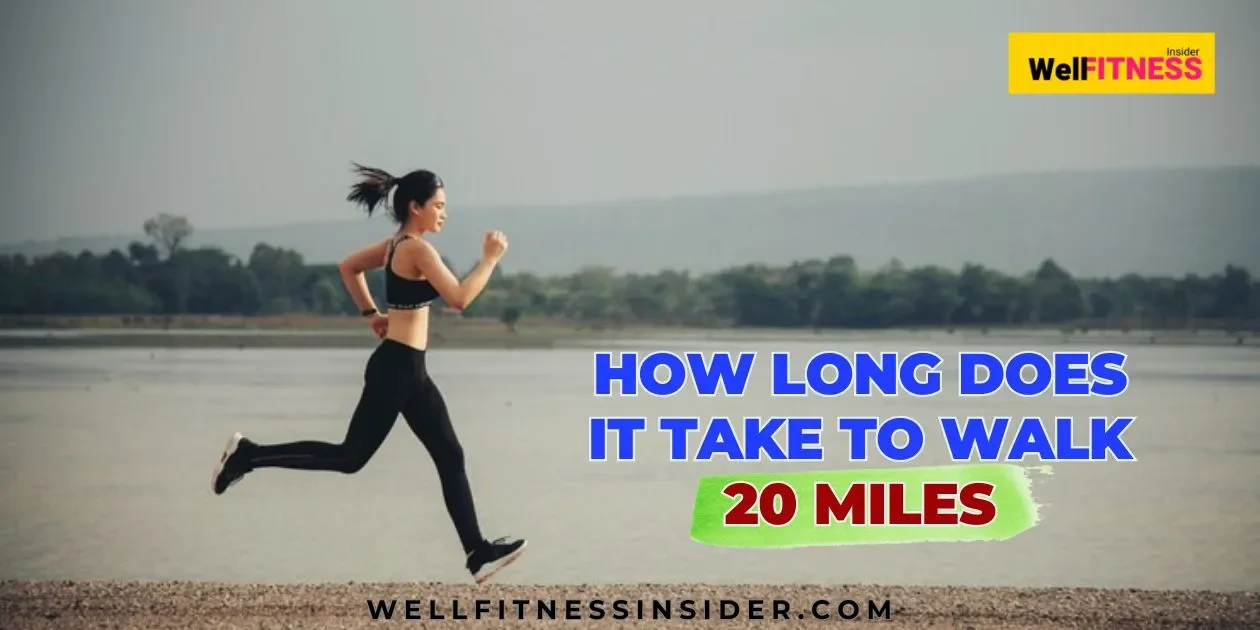Walking is a simple and effective way to stay active, yet it’s often underestimated. Whether you’re strolling through a park or hiking on a trail, walking can be a great way to improve your health. But how long does it take to walk 20 miles, especially when considering factors like age and gender?
- Walking 20 miles is no small feat, and the time it takes can vary widely.
- Age and gender play a significant role in how quickly you can cover this distance.
- Understanding these factors can help you set realistic goals and enjoy your walk.
In this article, we’ll explore how long it typically takes to walk 20 miles by different age groups and genders. We’ll look at factors that can affect your pace and offer tips on how to improve your walking speed and endurance. This information can be useful whether you’re planning a long walk, preparing for a challenge, or just curious about your walking abilities. With the right approach, walking 20 miles can be an achievable and enjoyable experience for people of all ages and fitness levels.
So, if you’ve ever wondered how long it would take to walk 20 miles, keep reading. You’ll find out what to expect based on your age and gender, and you might even be inspired to lace up your shoes and hit the pavement yourself.
II. Factors Affecting Walking Speed
Walking speed is influenced by a variety of factors, including age, gender, fitness level, and environmental conditions. Understanding these can help you better estimate how long it will take to walk 20 miles.
A. Age
Age is a major factor in walking speed. As we age, our pace often slows down due to changes in muscle strength, joint flexibility, and overall stamina.
- Youth (Under 20 Years): Younger individuals tend to walk faster due to higher energy levels and physical fitness.
- Young Adults (20-40 Years): This age group typically maintains a steady pace, benefiting from peak physical condition.
- Middle-Aged Adults (40-60 Years): Walking speed may begin to decrease slightly as the body starts to experience age-related changes.
- Older Adults (60+ Years): Older adults often walk at a slower pace due to decreased muscle mass and joint issues.
B. Gender
Gender can also affect walking speed. Men and women may have different paces due to physiological differences, such as muscle mass and body composition.
- Differences in Muscle Mass: Men generally have more muscle mass, which can contribute to a faster walking pace.
- Impact of Hormones: Hormonal differences, especially during certain life stages like menopause, can impact a woman’s walking speed.
- Cultural and Social Factors: In some cultures, social norms may influence how men and women approach physical activities like walking.
C. Fitness Level
Your fitness level plays a significant role in how quickly you can walk 20 miles. Regular walkers tend to have better stamina and can maintain a faster pace.
- Beginner: New walkers may find it challenging to keep a steady pace over long distances.
- Intermediate: Those who walk regularly can maintain a moderate pace and cover more distance comfortably.
- Advanced: Experienced walkers often walk faster and can endure long distances with ease.
D. Terrain and Environmental Factors
The environment you walk in can greatly affect your speed. Walking on different terrains or in various weather conditions can either slow you down or help you speed up.
- Flat vs. Hilly Terrain: Walking on flat terrain is easier and faster, while hilly or uneven terrain can slow you down.
- Urban vs. Rural Settings: Walking in an urban setting may involve stops at traffic lights or navigating crowds, which can affect your pace.
- Weather Conditions: Hot, cold, or rainy weather can influence how long it takes to walk 20 miles. For instance, extreme heat may slow you down, while a cool, dry day might help you maintain a steady pace.
E. Health and Physical Condition
Your overall health and any existing physical conditions also play a role in your walking speed.
- Impact of Chronic Conditions: Conditions like arthritis or respiratory issues can reduce your walking speed.
- Injury History: Past injuries, especially those involving the legs or back, may slow you down.
- Flexibility and Mobility: Good flexibility and mobility can help you maintain a steady pace, while stiffness or mobility issues might slow you down.
III. Average Walking Times for 20 Miles by Age and Gender
Understanding how long it typically takes to walk 20 miles can help you set realistic goals. Below, we break down average walking times based on age and gender.
A. General Statistics
Before diving into specifics, it’s important to understand the general statistics surrounding walking times for long distances.
- Data Sources: Various studies and fitness apps provide data on average walking speeds. This data is often collected from large groups of people across different demographics.
- Methodology: Average times are usually calculated by recording the time it takes for individuals to walk specific distances and then averaging these times across age groups and genders.
B. Breakdown by Age Groups
The time it takes to walk 20 miles can vary greatly depending on your age.
- Youth (Under 20 Years): Young people tend to walk faster, often covering 20 miles in 6-7 hours.
- Young Adults (20-40 Years): This age group may take around 7-8 hours, maintaining a moderate pace.
- Middle-Aged Adults (40-60 Years): Expect to spend about 8-9 hours walking 20 miles, as pace typically slows with age.
- Older Adults (60+ Years): Older individuals might take 9-10 hours or more, depending on their fitness level and health.
C. Gender Comparison
Gender differences can also influence walking times, with men often walking slightly faster than women.
- Male vs. Female Walking Times: Men generally complete 20 miles faster due to higher muscle mass and physical strength. They might finish in 7-8 hours, while women may take 8-9 hours.
- Insights into Gender Differences: These differences are not absolute and can vary based on individual fitness levels and experience.
- Case Studies or Examples: For instance, a study on marathon walkers showed that men tend to have slightly faster completion times, though women often outpace men in endurance over longer distances.
IV. Estimating Your Own Walking Time
Knowing the average times is helpful, but estimating your own walking time is even more valuable. Here’s how you can calculate it.
A. How to Calculate Your Walking Speed
To estimate how long it will take you to walk 20 miles, you need to know your walking speed.
- Using a Pedometer or GPS Device: Track your speed over a shorter distance, such as one mile. Multiply your time by 20 to estimate your 20-mile time.
- Tracking Time Over Shorter Distances: Walk a known distance (e.g., 5 miles) and record your time. This can give you a more accurate estimate for longer distances.
B. Adjusting for Age and Fitness Level
Your age and fitness level should be considered when estimating your walking time.
- Simple Formulas or Tools: Some online calculators allow you to input your age, weight, and usual walking pace to estimate how long it would take to walk 20 miles.
- Online Calculators: Use these tools to adjust your estimated time based on personal factors like age and fitness level.
C. Considerations for Setting a Realistic Pace
Setting a realistic pace is crucial to completing a 20-mile walk without exhausting yourself.
- Listening to Your Body: Pay attention to how your body feels during the walk. If you start to feel fatigued, it’s okay to slow down or take a break.
- Planning for Rest Breaks: Incorporate short breaks into your walk to prevent fatigue and maintain energy levels. A few minutes of rest every hour can make a big difference in your overall time.
V. Training Tips to Improve Walking Speed and Endurance
Improving your walking speed and endurance requires practice and the right approach. Here are some tips to help you get faster and go farther.
A. Building Stamina Over Time
To increase your walking endurance, start by gradually increasing your distance.
- Incremental Distance Increases: Start with shorter walks and slowly build up to longer distances. For example, if you usually walk 5 miles, try increasing it to 6 or 7 miles before attempting 20.
- Incorporating Interval Training: Add intervals of faster walking or light jogging into your routine. This can help improve your overall pace and stamina.
B. Strength and Flexibility Exercises
Strengthening your muscles and maintaining flexibility are key to walking faster and longer.
- Leg and Core Strengthening: Exercises like squats, lunges, and planks can build the muscles you need for walking. Strong legs and a stable core help maintain a good pace.
- Stretching Routines for Walkers: Incorporate regular stretching to keep your muscles flexible and reduce the risk of injury. Focus on the legs, hips, and lower back.
C. Proper Nutrition and Hydration
What you eat and drink plays a crucial role in your walking performance.
- Fueling Your Walk: Eat a balanced meal with carbohydrates, proteins, and fats before your walk. Consider carrying snacks like energy bars or nuts for long distances.
- Importance of Hydration Before, During, and After: Stay hydrated by drinking water before, during, and after your walk. Dehydration can slow you down and make the walk more difficult.
D. Choosing the Right Footwear and Gear
Wearing the right shoes and gear can make a big difference in your walking experience.
- Shoe Recommendations: Choose shoes that are comfortable, supportive, and designed for walking. Look for features like cushioned insoles and breathable materials.
- Clothing and Accessories for Comfort and Safety: Dress in layers to stay comfortable in different weather conditions. Consider wearing a hat, sunglasses, and sunscreen to protect yourself from the sun.
VI. The Benefits of Walking 20 Miles
Walking long distances, like 20 miles, offers numerous benefits beyond just physical fitness.
A. Physical Health Benefits
Walking 20 miles can significantly improve your physical health in various ways.
- Cardiovascular Health: Regular long walks strengthen your heart, improve circulation, and reduce the risk of heart disease.
- Weight Management: Walking is an effective way to burn calories and maintain a healthy weight. A 20-mile walk can burn up to 2,000 calories, depending on your weight and pace.
- Bone and Joint Health: Weight-bearing exercises like walking help maintain bone density and joint flexibility, reducing the risk of osteoporosis and arthritis.
B. Mental Health Benefits
Walking is also great for your mental well-being.
- Stress Relief: Walking helps reduce stress by releasing endorphins, which are natural mood boosters. It’s a great way to clear your mind and relax.
- Improved Mood: Regular walks can help combat feelings of depression and anxiety. The combination of physical activity and being outdoors is especially beneficial.
- Cognitive Function: Walking has been shown to improve cognitive function, helping with focus, memory, and problem-solving skills.
C. Social and Community Benefits
Walking can also be a social activity that strengthens community ties.
- Walking Groups: Joining a walking group can provide motivation and accountability. It’s also a great way to meet new people and enjoy social interaction.
- Events and Challenges: Participating in walking events or challenges can give you a sense of accomplishment. These events often bring communities together for a common cause, like raising funds for charity.
VII. Common Challenges and How to Overcome Them
Walking 20 miles is not without its challenges, but with the right preparation, you can overcome them.
A. Dealing with Fatigue
Fatigue is a common challenge during long walks, but it can be managed.
- Recognizing the Signs: Fatigue can manifest as heavy legs, slower pace, or general tiredness. It’s important to recognize these signs early to avoid overexertion.
- Strategies to Push Through: To manage fatigue, take short breaks, hydrate, and refuel with snacks. Listening to music or a podcast can also provide a mental boost to keep you going.
B. Preventing and Treating Blisters
Blisters are a common issue during long walks, but they can be prevented and treated effectively.
- Foot Care Tips: Wear well-fitting shoes and moisture-wicking socks to prevent blisters. Applying blister prevention products, like moleskin or blister pads, can also help.
- First Aid for Walkers: If you do get a blister, clean the area, apply an antiseptic, and cover it with a bandage to protect it while you walk.
C. Staying Motivated Over Long Distances
Maintaining motivation is key to completing a 20-mile walk.
- Setting Milestones: Break the walk into smaller milestones, such as reaching 5-mile or 10-mile marks. Celebrating these mini-goals can help keep you motivated.
- Using Music or Podcasts: Listening to your favorite music, an audiobook, or a podcast can make the time pass more quickly and keep you entertained.
- Walking with a Partner or Group: Walking with others can provide encouragement and make the experience more enjoyable. It’s also a great way to stay committed to your goal.
VIII. Real-Life Examples and Testimonials
Hearing from others who have successfully walked 20 miles can provide inspiration and practical insights.
A. Interviews with Regular Walkers
Talking to regular walkers from different age groups and genders can offer diverse perspectives on what it’s like to walk 20 miles.
- Different Age Groups: For example, younger walkers might focus on the speed aspect, while older walkers might emphasize endurance.
- Both Genders: Hearing from both men and women can provide insights into how gender affects the walking experience.
B. Success Stories
Success stories from people who have completed 20-mile walks can be motivating.
- People Who’ve Walked 20 Miles: These stories often highlight the preparation, challenges, and rewards of walking such a long distance.
- Challenges Overcome: Whether it’s dealing with an injury, fatigue, or bad weather, these stories show that it’s possible to overcome obstacles and achieve your goal.
C. Lessons Learned
Lessons learned from these experiences can be valuable for those planning their own long walk.
- Advice for New Walkers: Tips on pacing, hydration, and dealing with challenges can help new walkers prepare for their first 20-mile walk.
- Inspirational Takeaways: These stories can inspire others to set ambitious walking goals and push their limits.
IX. Conclusion
Walking 20 miles is a rewarding challenge that offers numerous benefits, both physical and mental. By understanding the factors that affect walking speed, estimating your own pace, and following training tips, you can successfully complete a 20-mile walk. Remember to listen to your body, stay motivated, and enjoy the journey.
- Recap of Key Points: We’ve covered how age, gender, and other factors influence walking time, as well as tips for improving your speed and endurance.
- Encouragement to Start Walking: Whether you’re an experienced walker or just starting out, walking 20 miles is an achievable goal with the right preparation.
- Call to Action: Why not set a goal to walk 20 miles? Share your experience with us, and let’s inspire others to take on this challenge!
X. Additional Resources
To help you on your walking journey, here are some resources you might find useful.
A. Recommended Reading
- Books: Consider reading books on walking for fitness, such as “Born to Walk” by Dan Rubinstein or “Walking for Fitness” by Nina Barough.
- Articles: Check out articles that dive deeper into topics like walking techniques, nutrition, and gear recommendations.
- Online Tools: Use online tools like MapMyWalk or Walkmeter to track your walks and monitor your progress.
B. Community and Support
- Walking Clubs and Groups: Join local walking clubs or groups to stay motivated and meet like-minded individuals.
- Online Forums: Participate in online forums or social media groups dedicated to walking. These communities can offer support, advice, and encouragement.
- Social Media Hashtags to Follow: Follow hashtags like #WalkingChallenge, #Walk20Miles, and #WalkingForFitness to connect with others and stay inspired.

Justin Taylor, a sports aficionado, brings unmatched energy and expertise to SpoortsUp.com. Known for his sharp commentary and insightful predictions, Justin’s writing resonates with fans across the globe. His unique perspective on the sports world keeps readers both informed and entertained.











